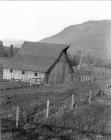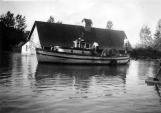1
The farm surrounding the Kilby General Store and owned by the Kilby family was called the Waterloo Farm, some say it was named so after the town of Waterloo Ontario and either Thomas or Eliza may have visited there before arriving in British Columbia. The Waterloo Dairy Farm was established in 1912, when Thomas Kilby purchased over two hundred acres adjacent to the store along with a small herd of cows and other livestock. Thomas Kilby was a farmer at heart, and he worked diligently and devoted much of his time to the farm while maintaining the store. Over the years, he expanded his herd from 10 cows to 32.2
Haying on Kilby's Waterloo Farm20th Century, Circa 1906
Kilby Historic Site, Harrison Mills, British Columbia, Canada
 Credits:
Credits:Fraser Heritage Society
3
After Acton and Jessie Kilby took over in 1922, they closed the farm temporarily, and Acton concentrated on renovating the store. However, in the mid 1920s Acton began building up a new herd of cows, specializing in the Jersey cow. By 1927 he was shipping milk, and became a founding director of the Milk Shippers Agency in 1935. While the farm was in operation, Acton Kilby had very strict policies regarding the treatment of his herds. Cows that produced milk were called "mothers," and were to be treated with patience and kindness. In fact a "Notice to the Help" regarding the treatment of the cattle is still posted at the Kilby Historic Site today. A dairy herd inspector also visited once a month to inspect the cream and milk, and also to inspect every cow.4
Exterior of Kilby Home with Prize Jersey Bull Standing in Foreground20th Century, Circa 1920
Kilby Historic Site, Harrison Mills, British Columbia, Canada
 Credits:
Credits:Fraser Heritage Society
5
Peter Kilby, son of Acton and Jessie Kilby remembers…. "I don't know why the Jersey breed was chosen, but I do know that the Jersey was quite docile and easy to work with. They also calved very easily and their milk had a very high butter fat/cream content which was much prized at the time. The only drawback was the Jersey bull. These were beautiful little animals but they were treacherous and as bad tempered as a grizzly with a sore paw. However, we always had one on the farm until after 1948."In order to register purebred animals, the farm had to have a name. The farm name assured the pure bred birth line and became the prefix to the name given to each animal. Each calf was registered at birth and the certificate of registration contained the name of the breeding bull and the mother (dam), both of whom would have been previously registered at birth with the Jersey Breeders Association of Canada. The animal in question was then given a registered name. For example, "Waterloo Bessie's Daisy," would indicate the Farm, Mother and Calf, respectively.
6
Cow Barn on the Waterloo Farm20th Century,
Kilby Historic Site, Harrison Mills, British Columbia, Canada
 Credits:
Credits:Fraser Heritage Society
7
Peter Kilby remembered…… "I loved the farm and would probably have remained home had we been able to sustain it. However, extenuating circumstances really conspired to spell the end. Firstly, the 1948 flood was catastrophic for us. We grew all of our own feed and the flood made it impossible for us to harvest what we would normally have been able to plant. With the land flooded, we had to buy feed when the cattle would normally have been grazing in our own pastures. Even when we brought the animals back to the farm, we had to buy feed to see us through more than a year until the next crops could be brought in. There was NO government assistance, and we had to buy and pay for the shipment of hay and dairy feed at hugely inflated prices. I think my parents had to resort to a mortgage to fund this.8
Gillnetter in Farmyard in Front of Horse Barn during the Fraser River 1948 Flood20th Century, Circa 1948
Kilby Historic Site, Harrison Mills, British Columbia, Canada
 Credits:
Credits:Fraser Heritage Society
9
The flood was a double whammy in that, even before 1948, virtually all of the outbuildings were slowly reaching their "past due" date. With the exception of the Milk House or Dairy Shed, they were all built on wooden sills. Time and weather had weakened these foundations and the family were already speculating on a new cow barn before the flood, and the spring of 1949 or 1950 would probably have been the time chosen for that task. Unfortunately, the flood accelerated the urgency to renovate. By this time, however, the Kilby's were struggling to feed the herd and a major rebuilding program was out of the question.10
Kilby Waterloo Farm during 1948 Flood20th Century, Circa 1948
Kilby Historic Site, Harrison Mills, British Columbia, Canada
 Credits:
Credits:Fraser Heritage Society
11
There was also a change taking place in farming techniques. The Kilby's were still farming with several teams of horses and equipment which dated back to at least the 1930s.12
Kilby Family Horse20th Century,
Kilby Historic Site, Harrison Mills, British Columbia, Canada
 Credits:
Credits:Fraser Heritage Society
13
If the Kilby family were going to carry on with the classic, self-sufficient farm, they had to make some major purchases of machinery. As an interim, they managed to buy a small new tractor to replace our venerable old 1935 Fordson, and began to convert everything except the hay wagons from horse to tractor drawn capability. They also embarked on major repairs and maintenance to the binder and threshing machine. Unfortunately, these changes would not be enough to sustain the farm.14
Fordson Tractor with Threshing Machine in front of Kilby Horse Barn20th Century, Circa 1930
Kilby Historic Site, Harrison Mills, British Columbia, Canada
 Credits:
Credits:Fraser Heritage Society